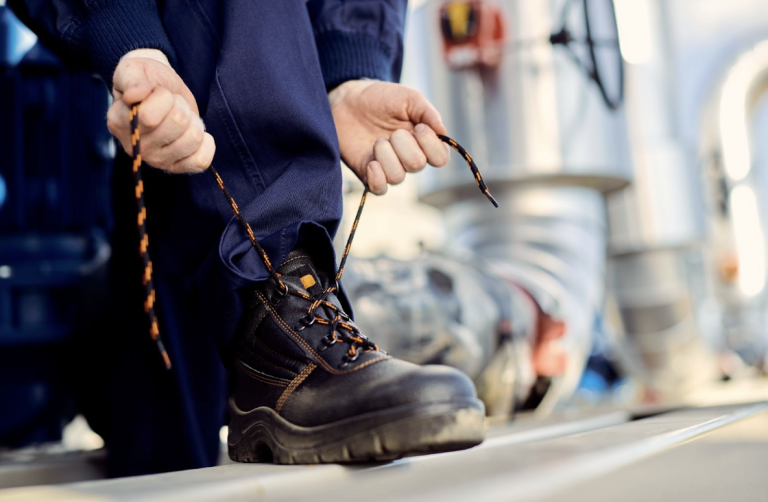In the UK, ensuring the safety and well-being of workers is paramount, and this is particularly critical in industries where feet are exposed to significant risks. Safety footwear plays a vital role in preventing a wide range of workplace injuries, from crushing and impact to slips, trips, and punctures. This article outlines some of the key UK industries where safety boots are mandatory or strongly recommended and provides an overview of the latest relevant legislation in 2025.
Industries Where Safety Footwear is Essential in the UK:
- Construction: This sector presents a multitude of foot hazards, including falling objects (bricks, tools), sharp materials (nails, glass), heavy machinery, and uneven surfaces. Robust safety boots with steel or composite toe caps, puncture-resistant midsoles, and good ankle support are often mandatory. Slip-resistant soles are also crucial due to varying terrain and potential spills.
- Manufacturing: Depending on the specific manufacturing environment, workers may face risks from falling objects, moving machinery, chemical splashes, and static electricity. Safety footwear requirements can range from basic steel-toe protection to specialised boots with chemical resistance or anti-static properties.
- Warehousing and Logistics: Employees in warehouses and logistics centres are at risk from falling objects, being struck by forklifts or other vehicles, and repetitive strain injuries. Safety boots with toe protection and good support are essential, and slip-resistant soles are vital on potentially slick surfaces.
- Agriculture and Forestry: Workers in these physically demanding sectors face hazards from heavy machinery, falling timber, sharp tools, and uneven terrain. Waterproof and durable safety boots with good grip and ankle support are often necessary.
- Healthcare (Specific Roles): While not universal, certain roles within healthcare, such as portering, maintenance, and laboratory staff handling hazardous materials, may require safety footwear to protect against dropped items, sharp objects, and spills.
- Utilities (Gas, Electricity, Water): Workers involved in the installation, maintenance, and repair of utilities often face risks from heavy equipment, uneven ground, and potential electrical hazards. Insulated and durable safety boots are frequently required.
- Emergency Services (Fire, Ambulance): While their footwear needs vary depending on the specific task, robust and protective boots are essential for firefighters and paramedics to navigate hazardous environments.
- Catering and Hospitality (Specific Roles): In commercial kitchens and food processing environments, slip-resistant safety shoes are crucial to prevent falls on wet or greasy floors. Some roles may also require toe protection.
UK Legislation and Safety Footwear in 2025:
The primary legislation governing workplace health and safety in the UK is the Health and Safety at Work etc. Act 1974. This act places a general duty on employers to ensure the health, safety, and welfare of their employees, as well as others who may be affected by their work activities.
Specifically regarding Personal Protective Equipment (PPE), including safety footwear, the key regulations are the Personal Protective Equipment at Work Regulations 1992 (as amended). These regulations place specific duties on employers, including:
- Assessing the risks: Employers must carry out a thorough risk assessment to identify hazards in the workplace that could cause foot injuries.
- Providing suitable PPE: Where risks cannot be adequately controlled by other means, employers must provide suitable PPE, including safety footwear, free of charge to employees.
- Ensuring PPE is used correctly: Employers must take reasonable steps to ensure that employees use the PPE provided in accordance with instructions and training.
- Maintaining PPE: PPE must be properly maintained and replaced when necessary.
- Providing information, instruction, and training: Employees must be provided with adequate information, instruction, and training on the correct use, maintenance, and limitations of the PPE provided.
Relevant Standards:
Safety footwear supplied in the UK must meet relevant European standards, which are typically indicated by a CE marking and specific EN ISO standards. The most common standard for safety footwear is EN ISO 20345. This standard specifies basic and additional requirements for safety footwear, including levels of protection against impact, compression, and other hazards. The specific safety rating (e.g., S1, S3, S5) indicates the level and type of protection offered by the footwear.
Developments in 2025:
As of 2025, there haven’t been any radical overhauls of the core legislation regarding safety footwear. However, employers and workers should be aware of ongoing areas of focus:
- Emphasis on Comfort and Ergonomics: There’s a growing recognition of the link between comfortable and well-fitting safety footwear and increased compliance and productivity. Employers are increasingly looking for options that not only meet safety standards but also minimise fatigue and musculoskeletal issues.
- Sustainability in PPE: Similar to other industries, there’s a growing interest in more sustainable options for PPE, including safety footwear made from recycled or renewable materials. While not yet a legal requirement, employers may increasingly consider these factors in their procurement decisions.
- Technological Advancements: As mentioned in previous discussions, advancements in materials and smart technology are continuing to influence the design and functionality of safety footwear. Employers should stay informed about these developments and consider how they can enhance worker safety and well-being.
Conclusion:
Safety footwear remains a critical element of workplace safety in numerous UK industries. Employers have a clear legal responsibility to assess risks and provide appropriate PPE that meets relevant standards. By understanding the specific hazards within their sector and staying informed about the latest legislation and advancements in safety footwear, UK businesses can ensure the safety and well-being of their workforce in 2025 and beyond.


